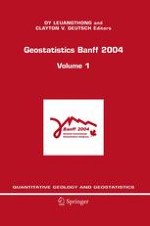2005 | OriginalPaper | Buchkapitel
Reservoir Facies Modelling: New Advances in MPS
verfasst von : Andrew Harding, Sebastien Strebelle, Marjorie Levy, Julian Thorne, Deyi Xie, Sebastien Leigh, Rachel Preece, Robert Scamman
Erschienen in: Geostatistics Banff 2004
Verlag: Springer Netherlands
Aktivieren Sie unsere intelligente Suche, um passende Fachinhalte oder Patente zu finden.
Wählen Sie Textabschnitte aus um mit Künstlicher Intelligenz passenden Patente zu finden. powered by
Markieren Sie Textabschnitte, um KI-gestützt weitere passende Inhalte zu finden. powered by
Over the last several years, Multiple Point statistical Simulation (MPS) has emerged as a practical tool in the characterization and modeling of petroleum reservoirs. In this paper, we describe recent developments in facies modeling at ChevronTexaco and illustrate this with a case history of its use at a ChevronTexaco operated field. Our approach is based on our implementation and continuing development of MPS. Our MPS workflow models depositional facies in a four step process.
The first step is the construction of the Training Image used by MPS algorithms. The second step is the compilation of a three-dimensional azimuth field. This information field imparts areal geological trends at the scale of the reservoir model and is derived from well and seismic information together with sub-regional geological trends. The third step is to calculate a facies probability cube. The cube defines the facies proportions in the model and is derived from well and seismic information. The final step is the application of the MPS. The result is a realization of the facies model with all the characteristics of the three components described. The workflow facilitates construction of multiple realizations of the model.
Uncertainty in facies occurrence is not, however, limited to multiple realizations. Provided that the training image is sufficiently rich with a sound knowledge of the geology, correctly represented, a single training image can be use and multiple azimuth fields and facies probability scenarios incorporated into the modeling. This latter technique will be illustrated.
Our approach results in models that represent geology very well. Obtaining this characteristic is not solely a function of the algorithms and workflows used. Sound and detailed sequence stratigraphic analysis is an absolute prerequisite, even where well data is sparse.
